Ancient Environmental Preference and the Site Selection Pattern Based on the Edge Effect and Network Structure in An Ecosystem
Abstract
1. Introduction
2. Methodology
2.1. Geomantic Environment
2.2. Edge Effect
2.3. Ecological Network
2.4. Materials
3. Study Background
4. Results and Discussion
4.1. Ecological Pattern Analysis
4.2. Edge Effect of the Ecological Transition Zone
4.3. Ecological Networks and Centrality Importance
4.4. Exploration of Undiscovered Archaeological Site
5. Conclusions
Author Contributions
Funding
Acknowledgments
Conflicts of Interest
References
- Hambrecht, G.; Anderung, C.; Brewington, S.; Dugmore, A.; Edvardsson, R.; Feeley, F.; Gibbons, K.; Harrison, R.; Hicks, M.; Jackson, R.; et al. Archaeological sites as distributed long-term observing networks of the past (DONOP). Quat. Int. 2018. [Google Scholar] [CrossRef]
- David, W.P. The cosmo-political background of heaven’s mandate. Early China 1995, 20, 121–176. [Google Scholar] [CrossRef]
- Agapiou, A.; Alexakis, D.D.; Lysandrou, V.; Sarris, A.; Cuca, B.; Themistocleous, K.; Hadjimitsis, D.G. Impact of urban sprawl to cultural heritage monuments: The case study of Paphos area in Cyprus. J. Cult. Herit. 2015, 16, 671–680. [Google Scholar] [CrossRef]
- Shi, Z. From the determining orientation to the compass: The great historical contribution of ancient geomancer. In Study of Feng Shui Theory, 2nd ed.; Wang, Q., Ed.; Tianjin University Press: Tianjin, China, 2005; pp. 266–291. ISBN 978-7-5618-1008-8. [Google Scholar]
- Guo, J. Joseph Needham’s science and civilisation in China and the founding of the institute for the history of natural science in China. Stud. Hist. Nat. Sci. 2007, 26, 273–292. [Google Scholar] [CrossRef]
- Coggins, C.; Chevrier, M.; Dwyer, L.; Longway, M.; Tiso, P.; Li, Z. Village fengshui forests of southern China: Culture, history, and conservation status. ASIA Netw. Exch. 2012, 19, 52–67. [Google Scholar] [CrossRef]
- Shao, C. The Influence of Fengshui to Ancient Emperor Mausoleum. Master’s Thesis, Shaanxi Normal University, Xi’an, China, 2013. [Google Scholar]
- Yun, Q. The Study on the Application of Chinese Traditional Fengshui Theory in Ancient Town’s Protection. Master’s Thesis, Sichuan Agricultural University, Chengdu, China, 2014. [Google Scholar]
- Wikipedia. Available online: https://en.wikipedia.org/wiki/Feng_shui (accessed on 26 October 2018).
- Bruun, O. Fengshui in China: Geomantic Divination between State Orthodoxy and Popular Religion, 2nd ed.; NIAS Press: Copenhagen, Denmark, 2011; pp. 1–3. ISBN 978-87-91114-57-1. [Google Scholar]
- Su, B. A Brief Description of the Three Sung Dynasty Tombs Excavated at Pai-Sha, 2nd ed.; Cultural Relics Press: Beijing, China, 2002; pp. 99–124. ISBN 7-5010-1338-1/K·587. [Google Scholar]
- Wang, Q. Study of golden well in underground palace of Qing Dynasty. Cult. Relics 1986, 7, 67–76. [Google Scholar]
- Liu, P.L. Fengshui—Chinese View of the Environment, 1st ed.; San Lien Book Store: Shanghai, China, 1995; pp. 1–8. ISBN 9787542608963. [Google Scholar]
- Yu, X. The Theory and Practice of Fengshui in Ancient China, 1st ed.; Guangming Daily Press: Beijing, China, 2005; pp. 1–32. ISBN 780206151. [Google Scholar]
- Eilel, J.E.; Michell, J. Fengshui—The Science of Sacred Landscape in Old China, 7th ed.; Synergetic Press: Sante Fe, NM, USA, 1993; pp. 1–13. ISBN 9780907791188. [Google Scholar]
- Magli, G. Royal mausoleums of the western Han and of the Song Chinese dynasties: A satellite imagery analysis. Archaeol. Res. Asia 2018, 15, 45–54. [Google Scholar] [CrossRef]
- Gui, P. Study on the Evolution and Reconstruction of the Cultural Landscape of DongCun Village. Master’s Thesis, Suzhou University of Science and Technology, Suzhou, China, 2014. [Google Scholar]
- Yang, L. The Research of Fenghui Theory and the Building of Ancient Shangshui Cities. Ph.D. Thesis, Chongqing University, Chonqing, China, 2005. [Google Scholar]
- Ye, Q. The Space Syntax Research on Inhabitation Environment of Traditional Settlement. Master’s Thesis, Zhejiang University, Hangzhou, China, 2006. [Google Scholar]
- Spear, W. Fengshui Made Easy: Designing Your Life with the Ancient Art of Placement, 1st ed.; HarperSanFrancisco Press: San Francisco, CA, USA, 2016; pp. 5–13. ISBN 9780062510235. [Google Scholar]
- Wydra, N.; Baigelman, L. Feng Shui Principles for Building and Remodeling: Creating a Space That Meets Your Needs and Promotes Well-Being, 1st ed.; McGraw-Hill Press: New York, NY, USA, 2002; pp. 1–8. ISBN 978-0809297382. [Google Scholar]
- Wang, J.; Wang, J. The relationship between the choice of village location and geomantic pattern in ancient Chinese agricultural society. J. Xi’an Univ. Arch. Technol. 2005, 24, 17–21. [Google Scholar]
- Heidari, A.A.; Ghalavand, S.T.; Vasigh, B. Making the public spaces with spiritual strategy in Bushehr. Procedia Soc. Behav. Sci. 2014, 159, 722–731. [Google Scholar] [CrossRef][Green Version]
- Hofmeister, J.; Hošek, J.; Brabec, M.; Střalková, R.; Mýlová, P.; Bouda, M.; Pettit, J.L.; Rydval, M.; Svoboda, M. Microclimate edge effect in small fragments of temperate forests in the context of climate change. For. Ecol. Manag. 2019, 448, 48–56. [Google Scholar] [CrossRef]
- Andrieu, E.; Cabanettes, A.; Alignier, A.; Halder, I.V.; Alard, D.; Archaux, F.; Barbaro, L.; Bouget, C.; Bailey, S.; Corcket, E.; et al. Edge contrast does not modulate edge effect on plants and pollinators. Basic Appl. Ecol. 2018, 27, 83–95. [Google Scholar] [CrossRef]
- Mahmoudi, S.; Ilanloo, S.S.; Shahrestanaki, A.K.; Valizadegan, N.; Yousefi, M. Effect of human-induced forest edges on the understory bird community in Hyrcanian forests in Iran: Implication for conservation and management. For. Ecol. Manag. 2016, 382, 120–128. [Google Scholar] [CrossRef]
- Tian, C.; Yang, X.; Liu, Y. Edge effect and its impacts on forest ecosystem: A review. Chin. J. Appl. Ecol. 2011, 22, 2184–2192. [Google Scholar] [CrossRef]
- Zhou, T.; Peng, S. Spatial scale and measurement of edge effect in ecology. Acta Ecol. Sin. 2004, 9, 3322–3333. [Google Scholar]
- Yuan, X. Research on Forest Landscape Patches Coupling Network and Dynamics: A Case Study in West Dongting Lake. Ph.D. Thesis, Central South University of Forestry and Technology, Changsha, China, 2012. [Google Scholar]
- Chen, L. Study on the Characteristics of Weighted Forest Landscape Patch Coupled Network Nodes. Master’s Thesis, Central South University of Forestry and Technology, Changsha, China, 2017. [Google Scholar]
- Freitas, S.R.; Constantino, E.; Alexandrino, M.M. Computational geometry applied to develop new metrics of road and edge effects and their performance to understand the distribution of small mammals in an Atlantic forest landscape. Ecol. Modell. 2018, 388, 24–30. [Google Scholar] [CrossRef]
- Chen, L.; Xu, J.; Fu, B.; Lv, Y. Quantitative assessment of patch edge effects and its ecological implications. Acta Ecol. Sin. 2008, 7, 1827–1832. [Google Scholar]
- Foltête, J. How ecological networks could benefit from landscape graphs: A response to the paper by Spartaco Gippoliti and Corrado Battisti. Land Use Policy 2019, 80, 391–394. [Google Scholar] [CrossRef]
- Vimal, R.; Mathevet, R.; Thompson, J.D. The changing landscape of ecological networks. J. Nat. Conserv. 2012, 20, 49–55. [Google Scholar] [CrossRef]
- Bergsten, A.; Zetterberg, A. To model the landscape as a network: A practitioner’s perspective. Landsc. Urban Plann. 2013, 119, 35–43. [Google Scholar] [CrossRef]
- Taylor, R.B.; Tulbure, M.G.; Broich, M. Impact of hydroclimatic variability on regional-scale landscape connectivity across a dynamic dryland region. Ecol. Indic. 2018, 94, 142–150. [Google Scholar] [CrossRef]
- Montis, S.D.; Caschili, S.; Mulas, M.; Modica, G.; Ganciu, A.; Bardi, A.; Ledda, A.; Dessena, L.; Laudari, L.; Fichera, C.R. Urban–rural ecological networks for landscape planning. Land Use Policy 2016, 50, 312–327. [Google Scholar] [CrossRef]
- Galpern, P.; Manseau, M.; Fall, A. Patch-based graphs of landscape connectivity: A guide to construction, analysis and application for conservation. Biol. Conserv. 2011, 144, 44–55. [Google Scholar] [CrossRef]
- Montis, A.D.; Ganciu, A.; Cabras, M.; Bardi, A.; Mulas, M. Comparative ecological network analysis: An application to Italy. Land Use Policy 2019, 81, 714–724. [Google Scholar] [CrossRef]
- Gao, Y.; Li, J.; Yuan, X.; Li, R.; Chen, L.; Chen, J. Comparison and analysis based on assessment on the importance of forest landscape patches coupling network node. J. Cent. South Univ. For. Technol. 2017, 37, 43–47. [Google Scholar] [CrossRef]
- Nowak, A.; Grunewald, K. Landscape sustainability in terms of landscape services in rural areas: Exemplified with a case study area in Poland. Ecol. Indic. 2018, 94, 12–22. [Google Scholar] [CrossRef]
- Wang, Y.; Lv, D. Nested structure analysis on the network scheme of traditional culture landscape space. South Archit. 2014, 3, 60–66. [Google Scholar] [CrossRef]
- Xu, L.; Wang, Y. A study of landscape feature protection planning based on heritage corridor network construction. J. Chin. Urban For. 2016, 14, 17–21. [Google Scholar] [CrossRef]
- Yang, L.; Yang, B. The variations of culture landscape and the changes of the structure of social network—A case study of the old town of Jinze and Liantang in the suburban of Shanghai. Fujian Archit. Constr. 2005, 2, 24–26. [Google Scholar]
- Jenkins, T.N. Chinese traditional thought and practice lessons for an ecological economics worldview. Ecol. Econ. 2002, 40, 39–52. [Google Scholar] [CrossRef]
- Xiao, W.; Zhang, S. Fully exploring traditional Chinese culture and promoting organic development of green city. Procedia Eng. 2017, 180, 1531–1540. [Google Scholar] [CrossRef]
- Liang, X. View the Chinese people’s feng shui from the settlement site. New Archit. 1988, 4, 67–71. [Google Scholar]
- Du, Y. The Research on the Planning of Mountain Residence Community Related Problems of Fengshui—Take the Qinling Angou Mountain Residence Community Planning as an Example. Master’s Thesis, Northwest University, Xi’an, China, 2010. [Google Scholar]
- Luo, G. Spacial Environmental Research of Residence and Water in Chongqing. Master’s Thesis, Chongqing University, Chongqing, China, 2002. [Google Scholar]
- Shang, K. The composition, ecological environment and landscape of Chinese feng shui pattern. In Study of Feng Shui Theory, 2nd ed.; Wang, Q., Ed.; Tianjin University Press: Tianjin, China, 2005; pp. 37–43. ISBN 978-7-5618-1008-8. [Google Scholar]
- Liu, S. Research on the Waterscape of the Ancient Hakka Village of Peitian in Fujian Province. Master’s Thesis, Fujian Agriculture and Forestry University, Fuzhou, China, 2014. [Google Scholar]
- Chen, W. Study on Utilization of Geomantic Theory in the Waterscape Build of Modern Living Environment. Master’s Thesis, Shanghai Jiaotong University, Shanghai, China, 2009. [Google Scholar]
- Wang, P.; Zheng, G.; Ge, X. On the scientific inquiry of the geomancy based on the geography. J. Anhui Agric. Sci. 2016, 44, 21–215. [Google Scholar] [CrossRef]
- Ma, J. Eco-design and the Application of Water of Traditional Houses in the Yangtze River Delta Region. Master’s Thesis, Southeast University, Nanjing, China, 2015. [Google Scholar]
- Zeng, Z. Research of Chinese Ancient Urban Mrphologies Based on Climate Adaptability. Ph.D. Thesis, Huazhong University of Science & Technology, Wuhan, China, 2011. [Google Scholar]
- Chen, B.; Coggins, C.; Minor, J.; Zhang, Y. Fengshui forests and village landscapes in China geographic extent, socioecological significance, and conservation prospects. Urban For. Urban Green. 2018, 31, 79–92. [Google Scholar] [CrossRef]
- Theatre, E.K.; Chow, C.H.S.H. The geographer and the fengshui practitioner: So close and yet so far apart? Aust. Geogr. 2000, 31, 309–332. [Google Scholar] [CrossRef]
- Liang, Y. Environmental ecology perspective in geomantic view of traditional village location layout in China. J. Guizhou Educ. Coll. 1997, 1, 86–89. [Google Scholar] [CrossRef]
- Xie, B. Discuss the Fengshui Folk by Geography Scientific Methods. Master’s Thesis, Westsouth University, Chongqing, China, 2014. [Google Scholar]
- Sun, F.; Feng, C.; Wang, Z.; Yan, T. Philosophical foundation of Chinese feng shui geography and man-land relationship. Trop. Geogr. 2014, 34, 581–590. [Google Scholar] [CrossRef]
- Mao, Y. Study on the Constructing Theory and Examples on Spatial from of Human Settlement in Mountainous Region—Case of Ancient China. Master’s Thesis, Chongqing University, Chongqing, China, 2009. [Google Scholar]
- Yang, K. Geographical thinking in feng shui theory. Zhouyi Res. 2006, 4, 92–96. [Google Scholar] [CrossRef]
- Marcos-Saiz, F.J.; Fernandez-Lomana, J.C. The Holocene archaeological research around Sierra de Atapuerca (Burgos, Spain) and its projection in a GIS geospatial database. Quat. Int. 2015, 1–23. [Google Scholar] [CrossRef]
- Garcia, A. GIS-based methodology for Palaeolithic site location preferences analysis. A case study from Late Palaeolithic Cantabria (Northern Iberian Peninsula). J. Archaeol. Sci. 2013, 40, 217–226. [Google Scholar] [CrossRef]
- Graves, D. The use of predictive modelling to target Neolithic settlement and occupation activity in mainland Scotland. J. Archaeol. Sci. 2011, 38, 633–656. [Google Scholar] [CrossRef]
- Murcia, C. Edge effects in fragmented forests: Implications for conservation. Trends Ecol. Evol. 1995, 10, 58–62. [Google Scholar] [CrossRef]
- Wang, B.; Peng, S. Analysis on the forest communities of Dinghushan Guangdong. X. Communities edge effect. Acta Sci. Nat. Univ. Sunyatseni 1986, 25, 52–56. [Google Scholar]
- Wang, G.; Li, J.; Zhao, C. Analysis of forest landscape edge effect intensity based on analytic hierarchy process. J. Cent. South Univ. For. Technol. 2012, 32, 110–116. [Google Scholar] [CrossRef]
- Wang, W.; He, D. Research progress of the edge effect of ecological landscape. J. Agric. Sci. 2012, 33, 62–66. [Google Scholar]
- Zhang, L.; Wang, H. Planning an ecological network of Xiamen Island (China) using landscape metrics and network analysis. Landsc. Urban Plann. 2006, 78, 449–456. [Google Scholar] [CrossRef]
- Patarasuk, R. Road network connectivity and land-cover dynamics in Lop Buri province, Thailand. J. Transp. Geogr. 2013, 18, 111–123. [Google Scholar] [CrossRef]
- Song, Y.; Liu, Y.; Wei, X. The characteristics of Wuhan city landscape ecology network pattern based on network analysis. Geomat. Spat. Inf. Technol. 2016, 39, 95–98. [Google Scholar] [CrossRef]
- Upadhyay, S.; Roy, A.; Ramprakash, M.; Idiculla, J.; Kumar, A.S.; Bhattacharya, S. A network theoretic study of ecological connectivity in Western Himalayas. Ecol. Modell. 2017, 359, 246–257. [Google Scholar] [CrossRef]
- Zhu, J.; Nie, Y.; Gao, H.; Liu, F.; Yu, L. GIS-based visibility network and defensibility model to reconstruct defensive system of the han dynasty in central Xinjiang, China. ISPRS Int. J. Geo Inf. 2017, 6, 247. [Google Scholar] [CrossRef]
- Duan, Y. Analysis of Urban Land Utilization Spatial-Temporal Change in Ningbo Based on Remote Sensing. Master’s Thesis, Ningbo University, Ningbo, China, 2011. [Google Scholar]
- Zhao, L. The Research of Ningbo City’s Urban Landscape System Spatial and Temporal Evolution Features. Master’s Thesis, Huazhong University of Science and Technology, Wuhan, China, 2015. [Google Scholar]
- Li, M.; Mo, D.; Sun, G.; Zhou, K.; Mao, L. Paleosalinity in Tianluoshan site and the relation between Hemudu Culture and its environmental background. J. Geogr. Sci. 2010, 20, 441–454. [Google Scholar] [CrossRef]
- Kang, Y.; Cheng, D.; Liang, Q. The characteristic of spatio-temporal evolution analysis of Hangzhou Bay om historical period. J. Zhejiang Norm. Univ. 2019, 42, 88–95. [Google Scholar] [CrossRef]
- Wu, W. Evolution of the Yaojiang River plain in alst 7000 years. Acta Ecol. Sin. 1988, 3, 269–275. [Google Scholar]
- Yang, Z. Prehistoric cultural sites of 5800 years ago was found in Xialwangdu, Fenghua District, where ningbo ancestors lived. Ningbo News Rep. 2017, 18, 66–67. [Google Scholar] [CrossRef]
- Feng, X.; Gao, M. Archaeogeographic analysis of early sites in ningshao area. Southeast Cult. 2004, 6, 31–37. [Google Scholar] [CrossRef]
- Menze, B.H.; Ur, J.A. Mapping patterns of long-term settlement in Northern Mesopotamia at a large scale. Proc. Natl. Acad. Sci. USA 2012, 109, E778–E787. [Google Scholar] [CrossRef]
- Nyle, C.B.; Ray, R.W. The Nature and Properities of Soil, 14th ed.; Li, B., Ed.; Science Press: Beijing, China, 2019; pp. 72–114. ISBN 978-03-060490-3. [Google Scholar]
- Jia, J. Environemtal Soil Science, 2nd ed.; Chemical Industry Press: Beijing, China, 2018; pp. 1–5. ISBN 978-7-122-32594-5. [Google Scholar]
- Ningbo Municipal Institute of Cultural Relics and Archaeology; Ningbo Cultural Relics Protection and Management institute. The Ancient Cities of Ningbo recorded in Literature. In Collection of Archaeological Research of Ningbo Relics (2), 1st ed.; Wang, J., Ed.; Science Press: Beijing, China, 2012; pp. 25–38. ISBN 9787030356215. [Google Scholar]
- Wang, J.; Xu, C.; Zhang, H. Some issues of the site of Gouzhang. Southeast Cult. 2013, 2, 94–100. [Google Scholar] [CrossRef]
- Ningbo Municipal Institute of Cultural Relics and Archaeology. Gouzhang City Site Archaeological Investigation and Exploration Report, 1st ed.; Science Press: Beijing, China, 2015; pp. 25–33. ISBN 978-7-03-040674-3. [Google Scholar]
- An Ancient Border City That Has Been Gone for Thousands of Years—Archaeological Investigation and Discovery of Yinxian in Baidu Country of Fenghua, Ningbo. Available online: http://www.kaogu.cn/cn/kaoguyuandi/kaogusuibi/2018/0619/62284.html (accessed on 19 June 2018).
- Lin, C. The integration of administrative divisions and local society: A case study of Shan and Mao Counties during the Qin, Han and Six Dynasties. Hist. Res. 2014, 6, 63–80. [Google Scholar]
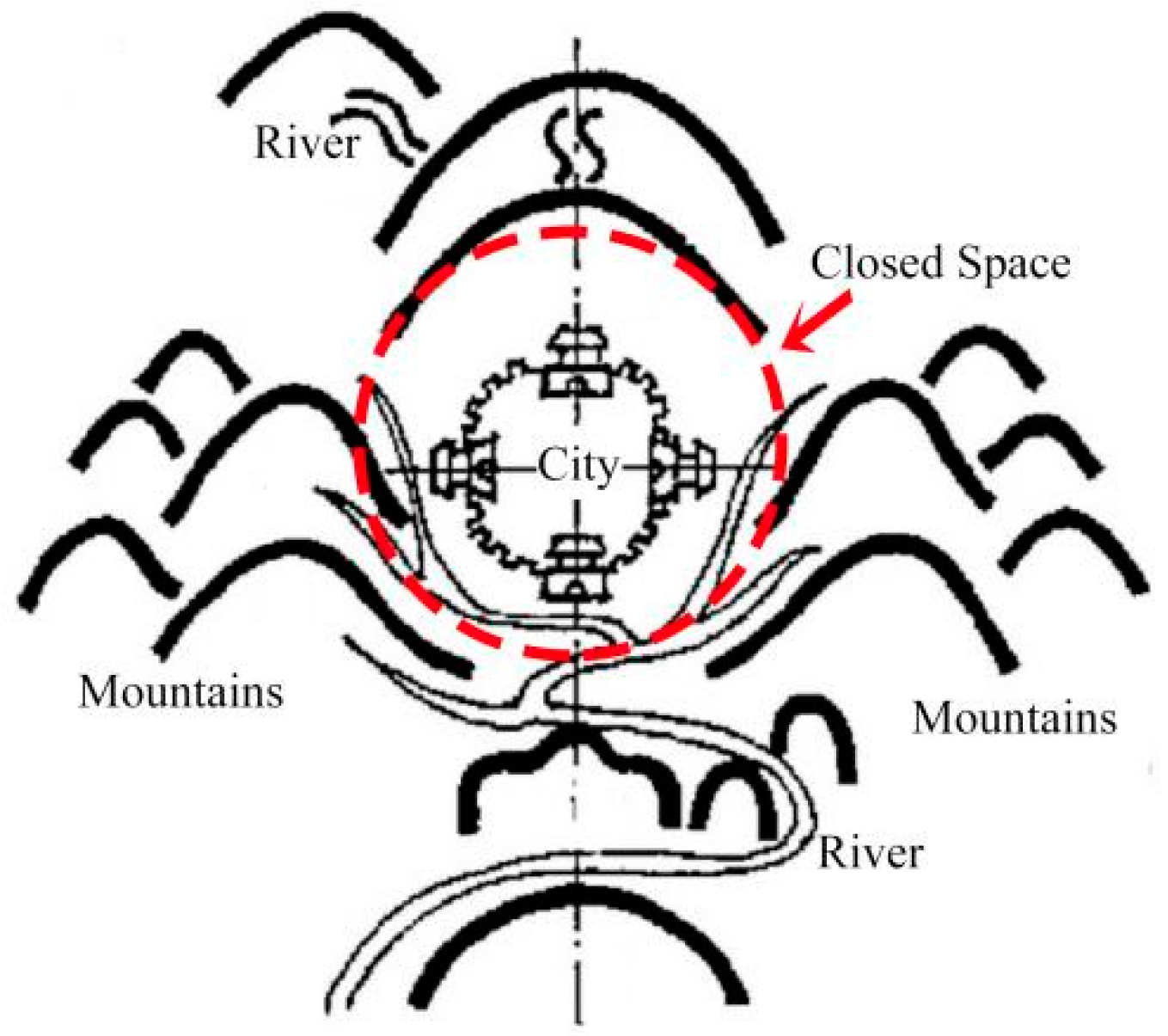
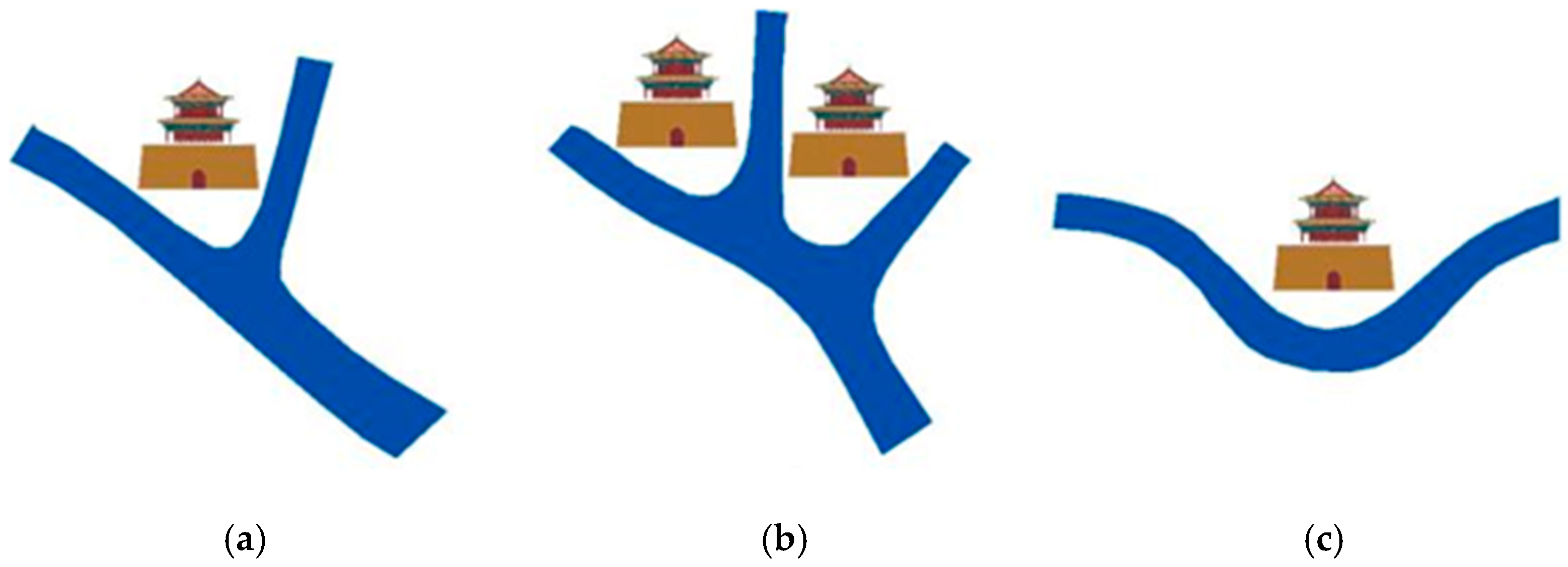
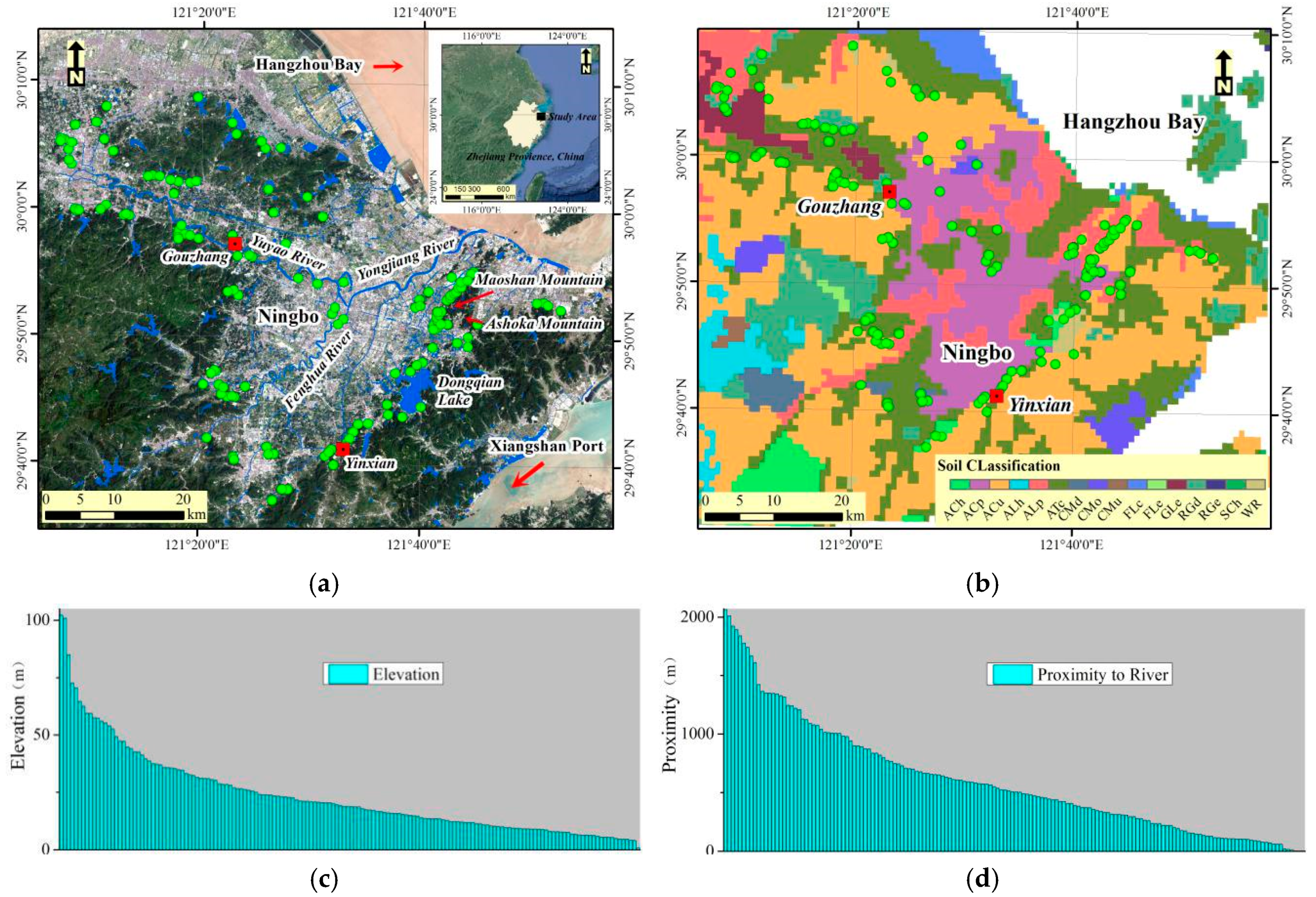
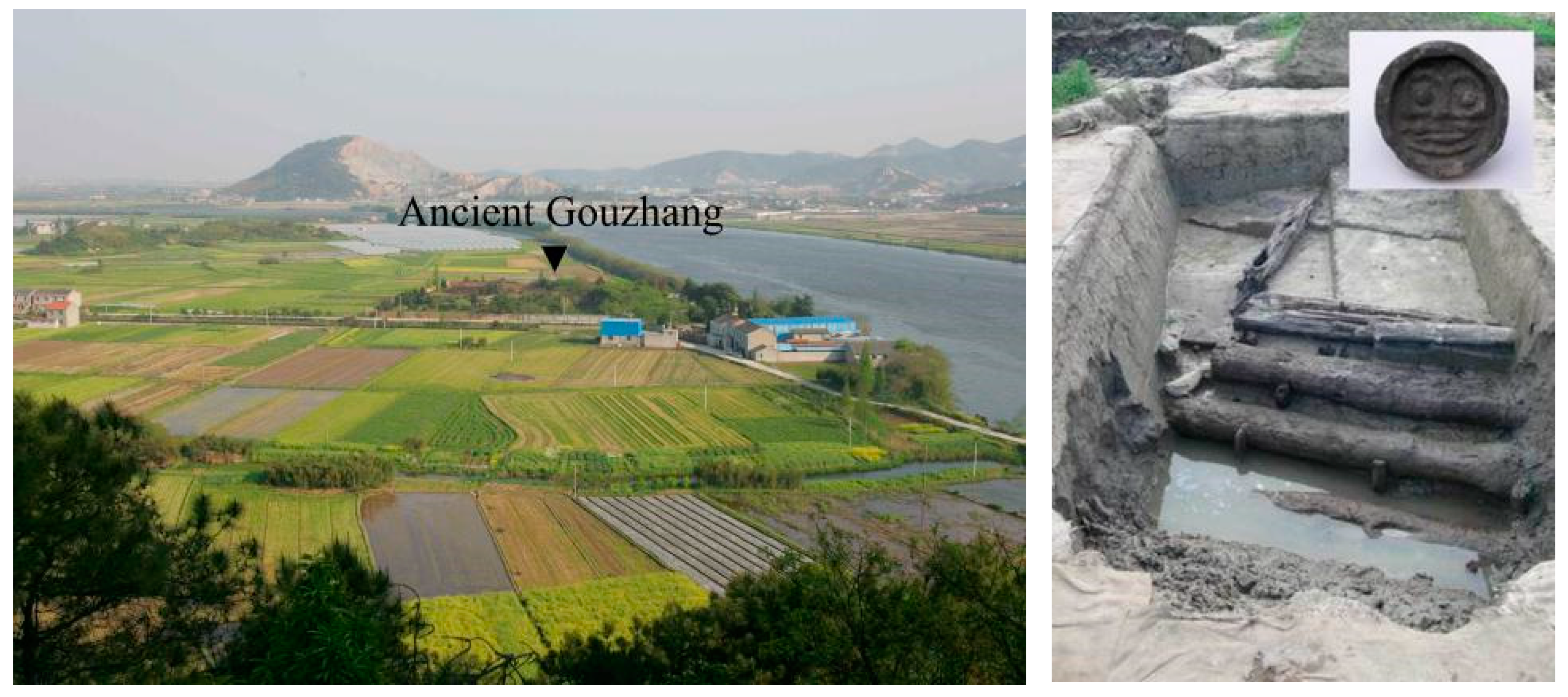
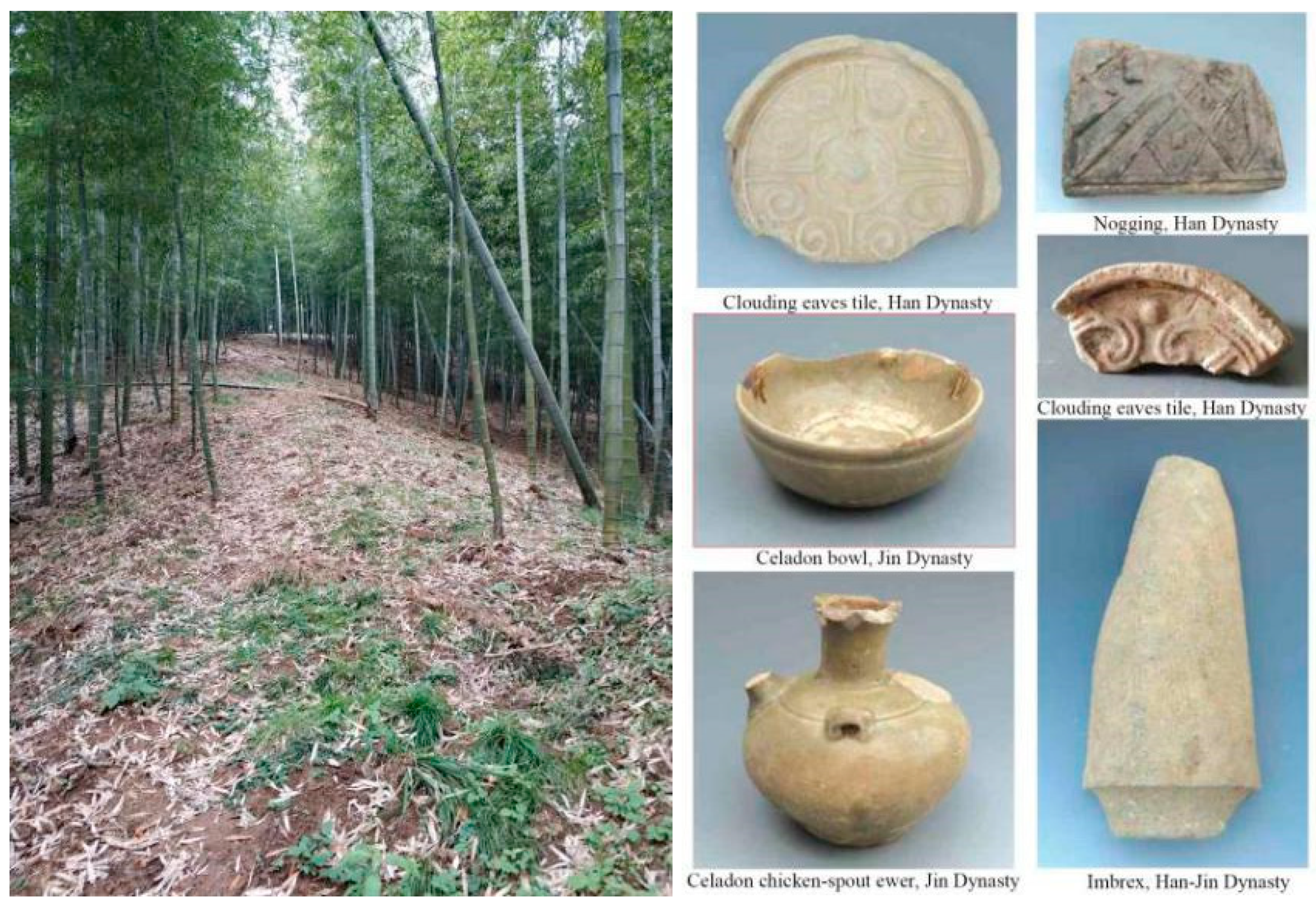
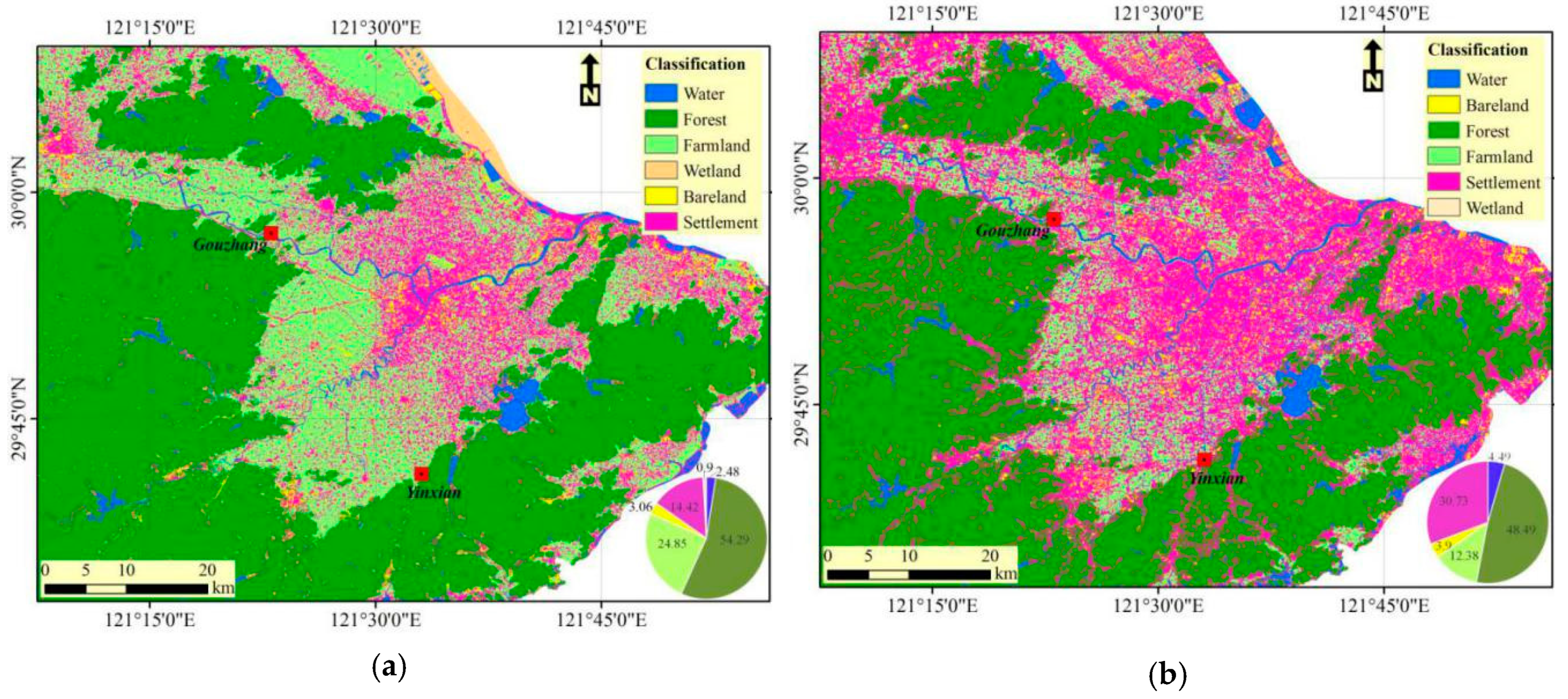
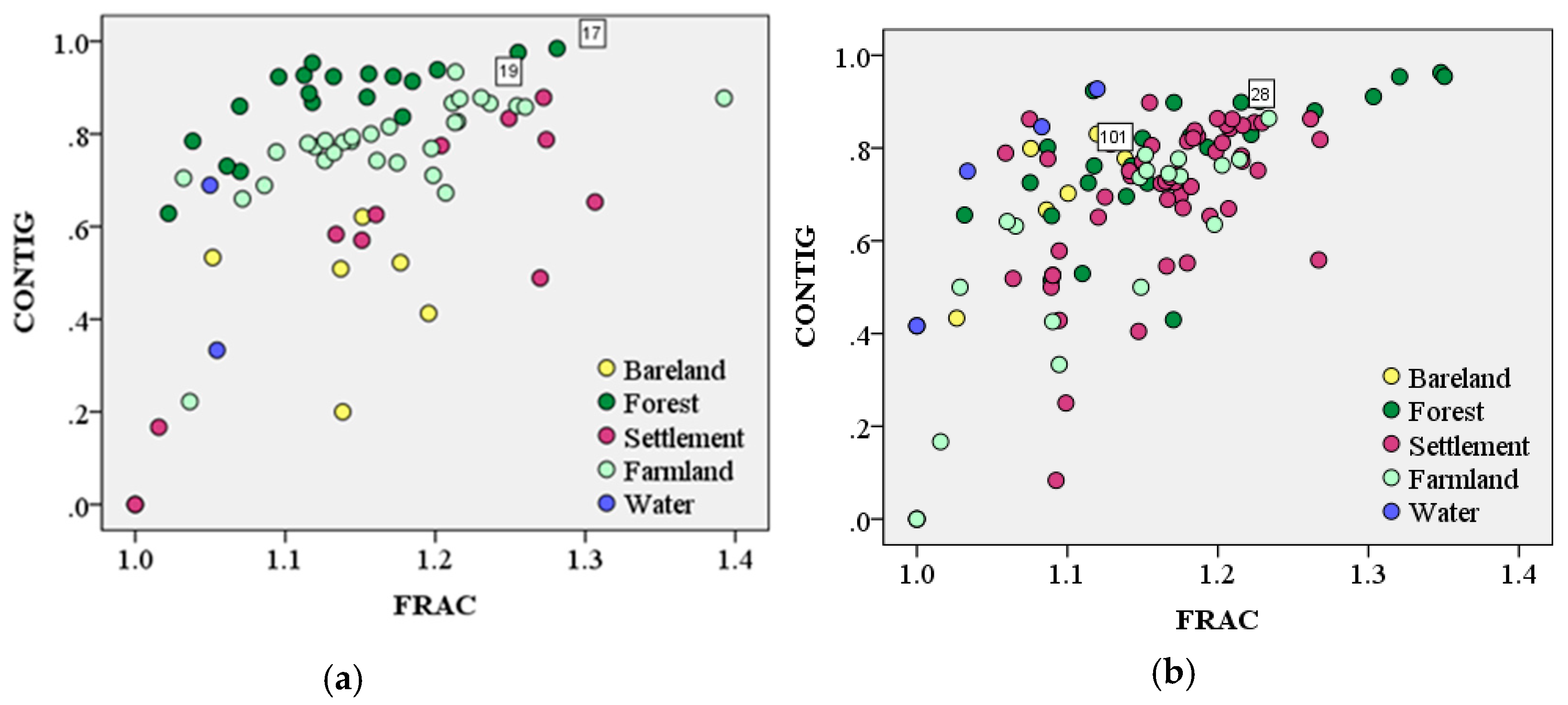
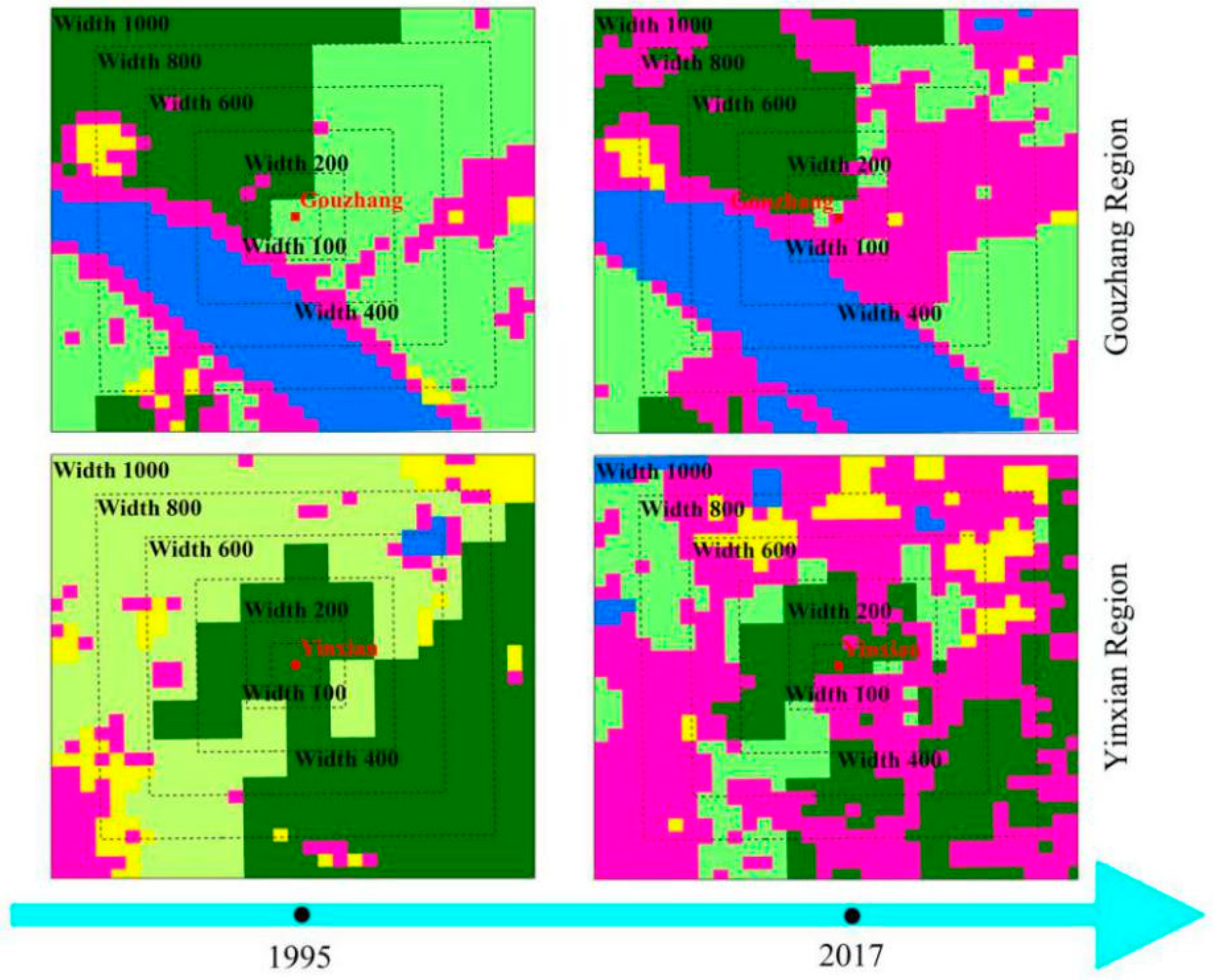
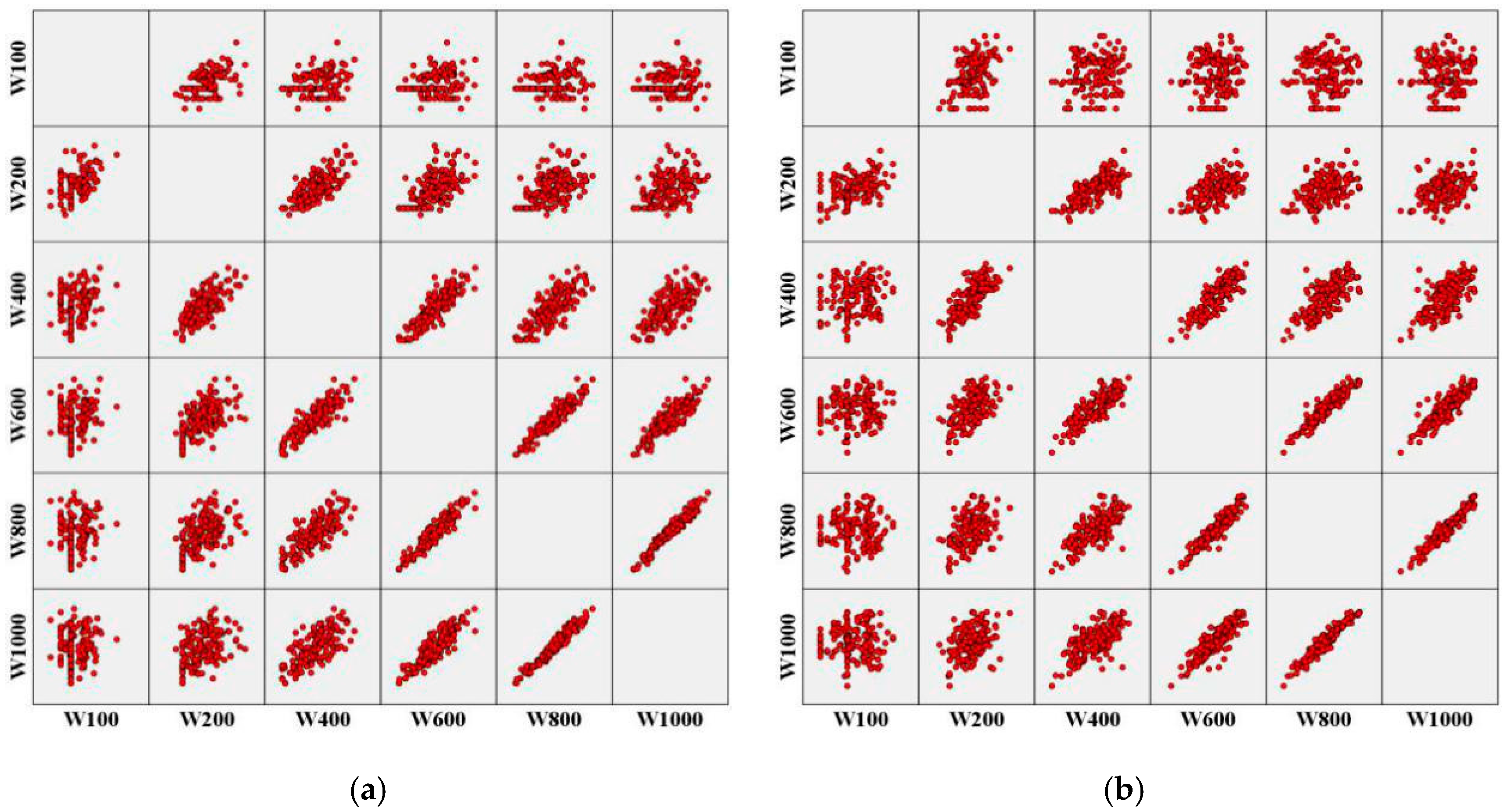
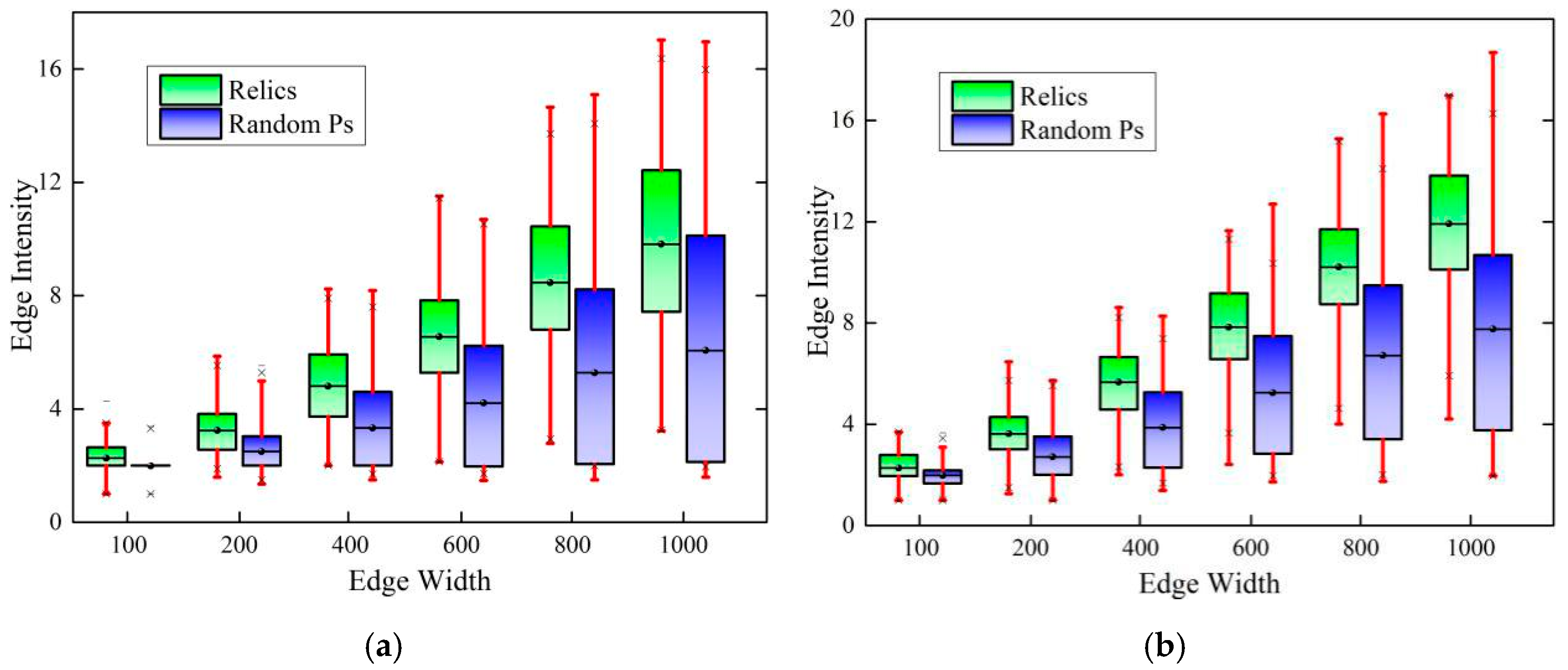
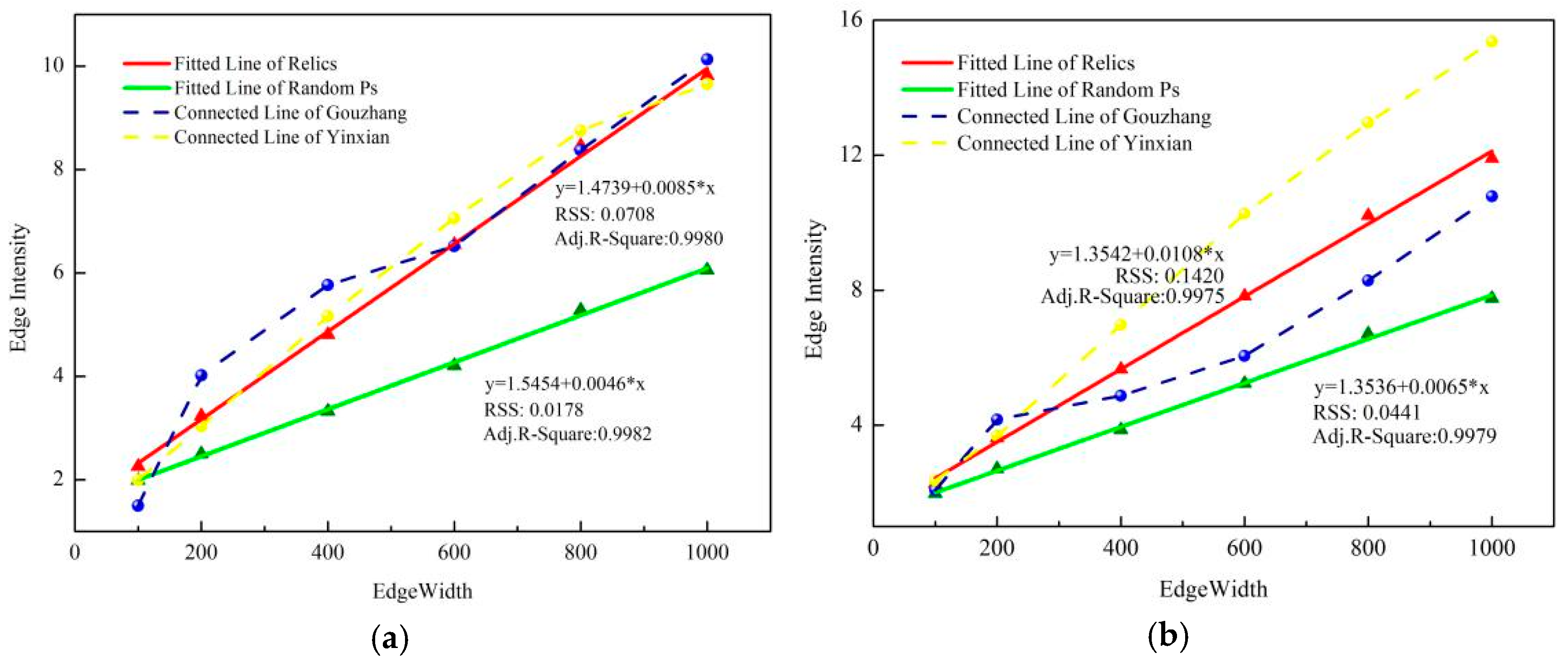
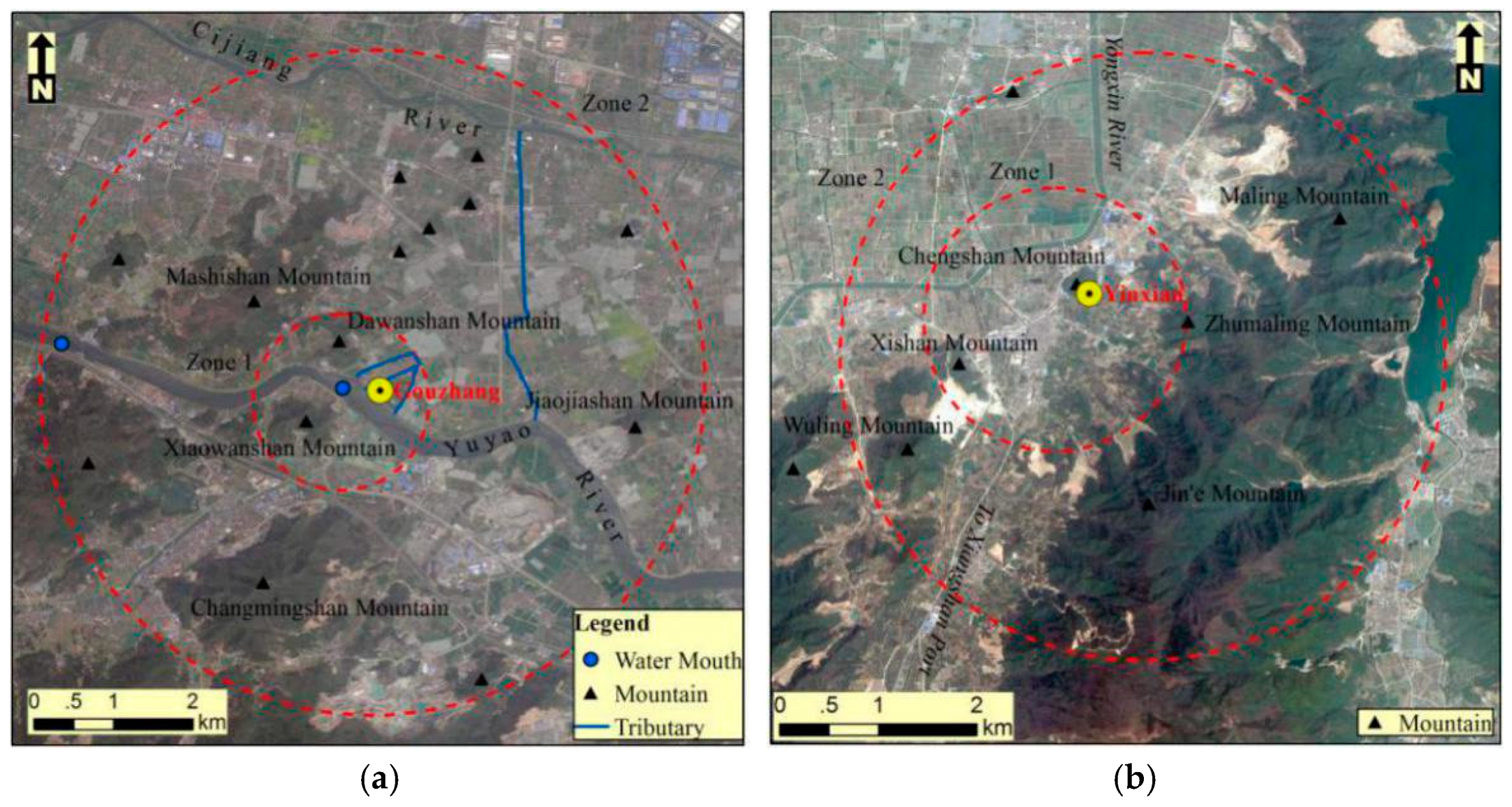
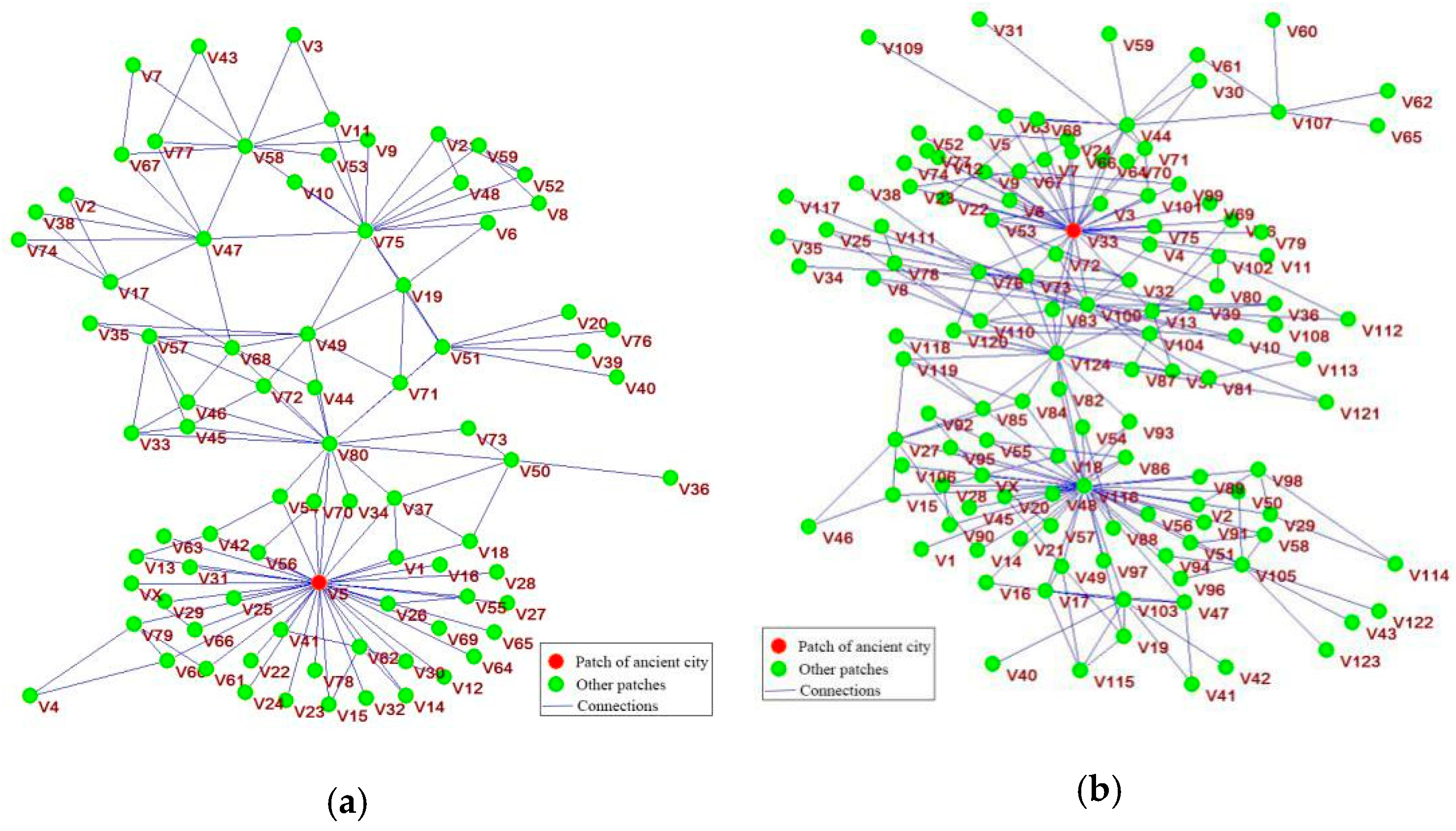
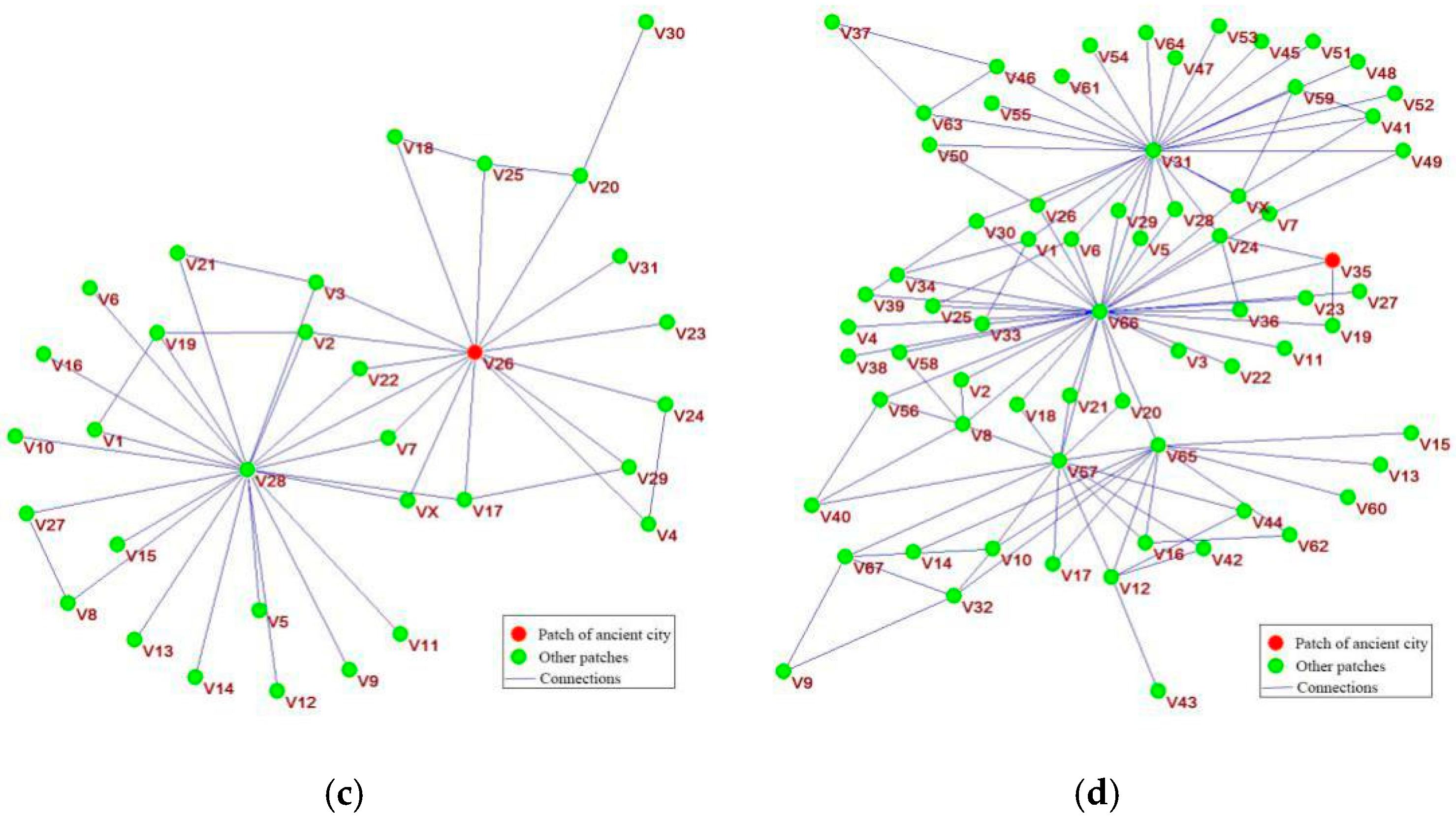
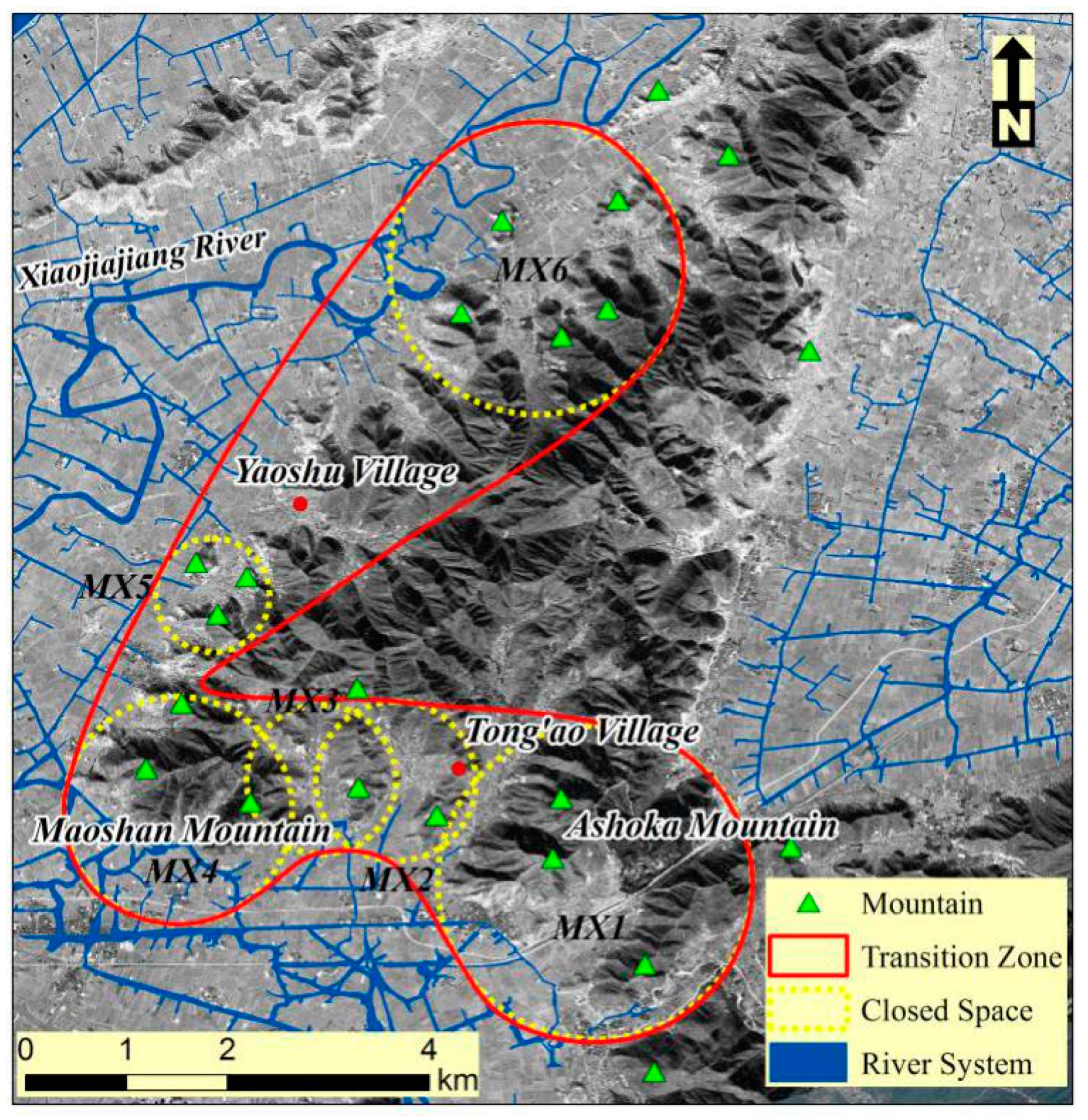
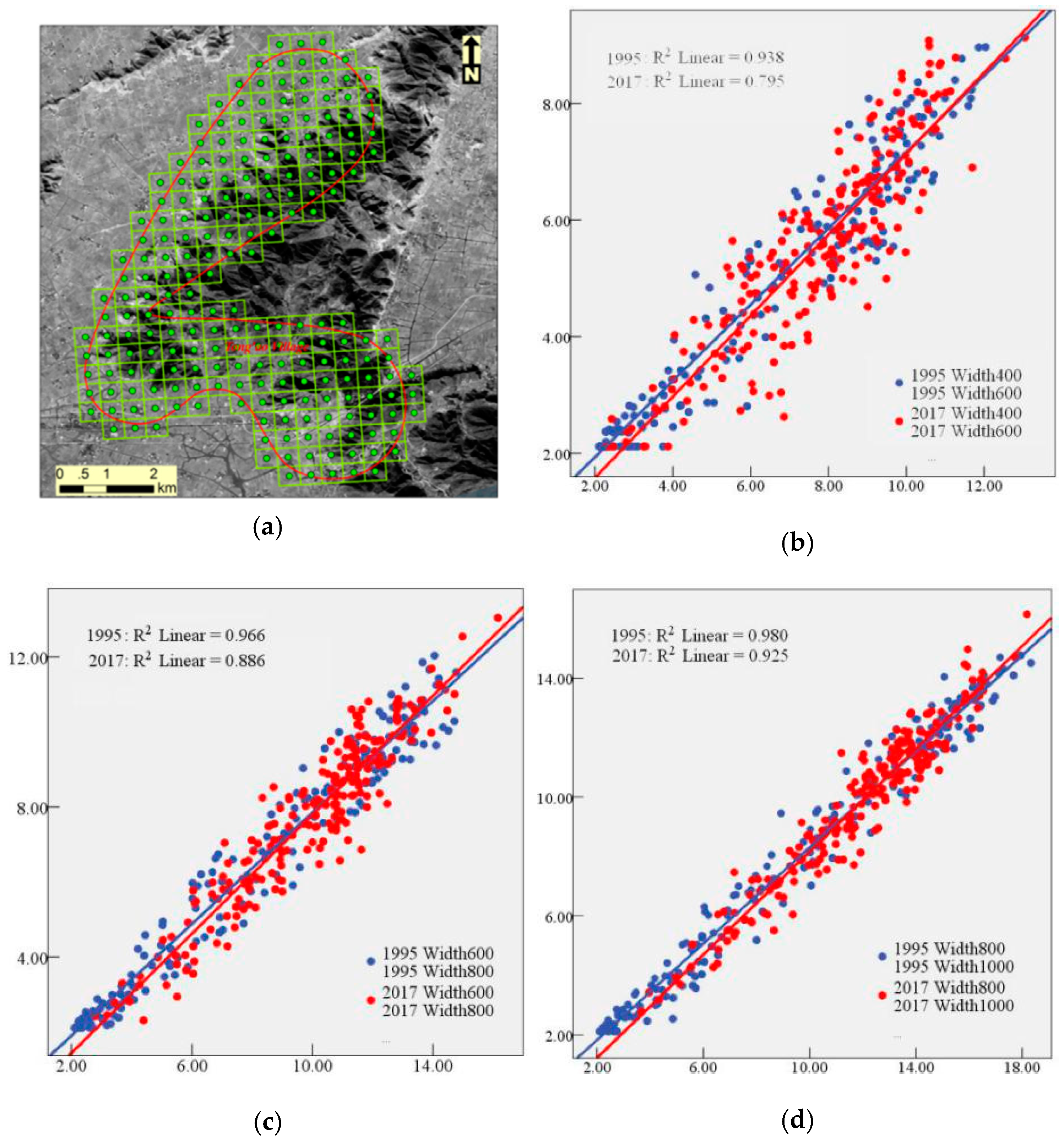
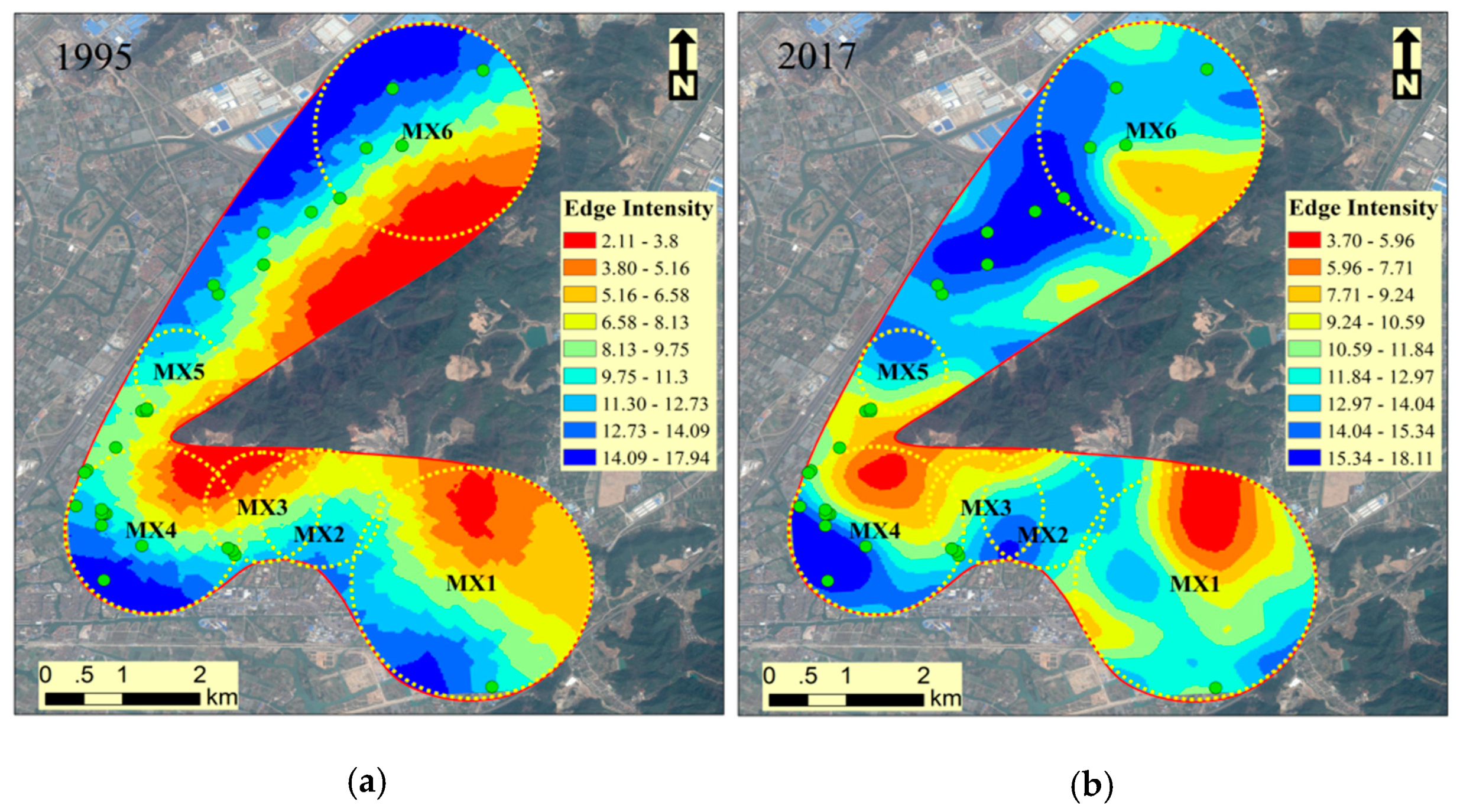
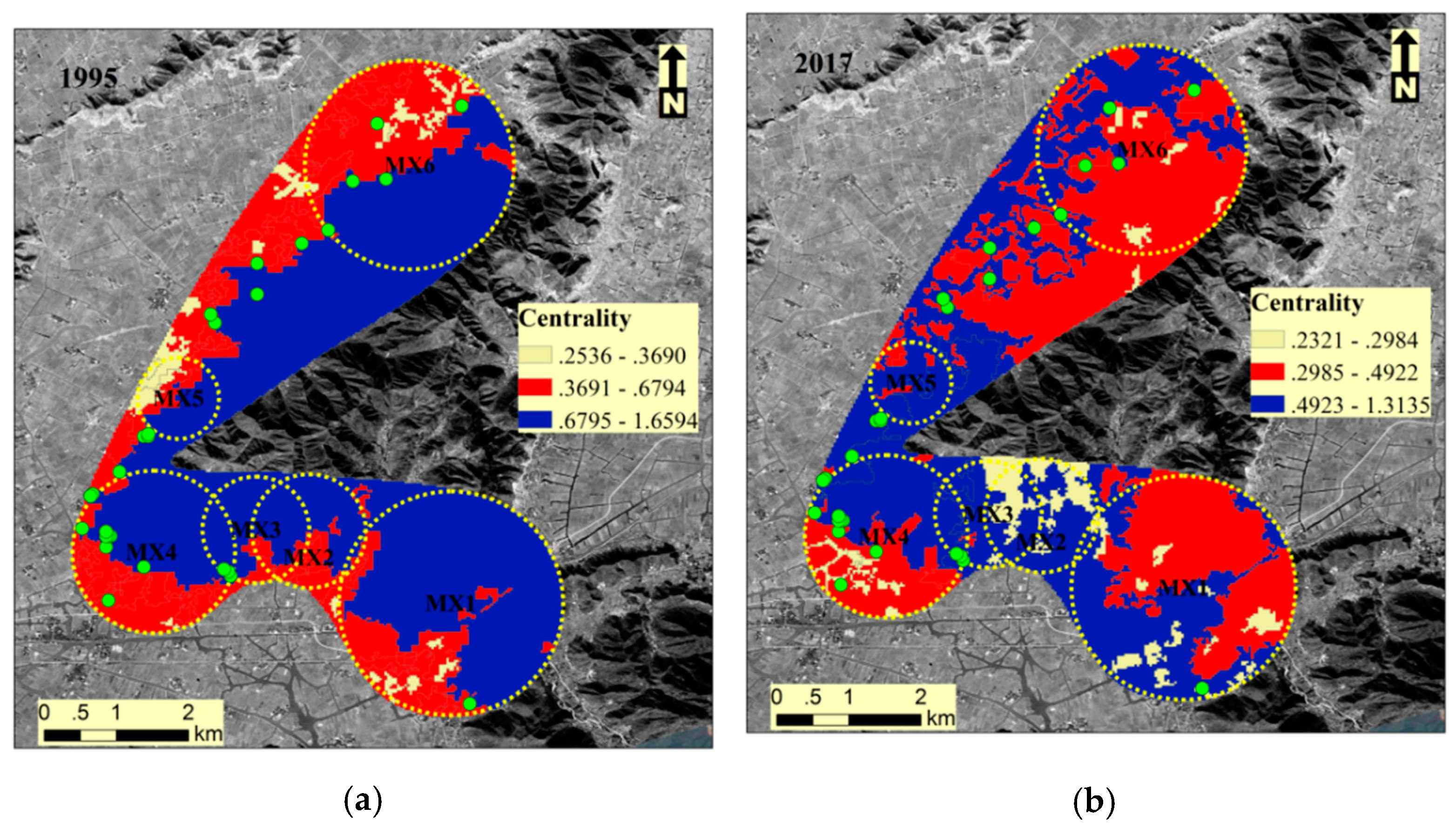
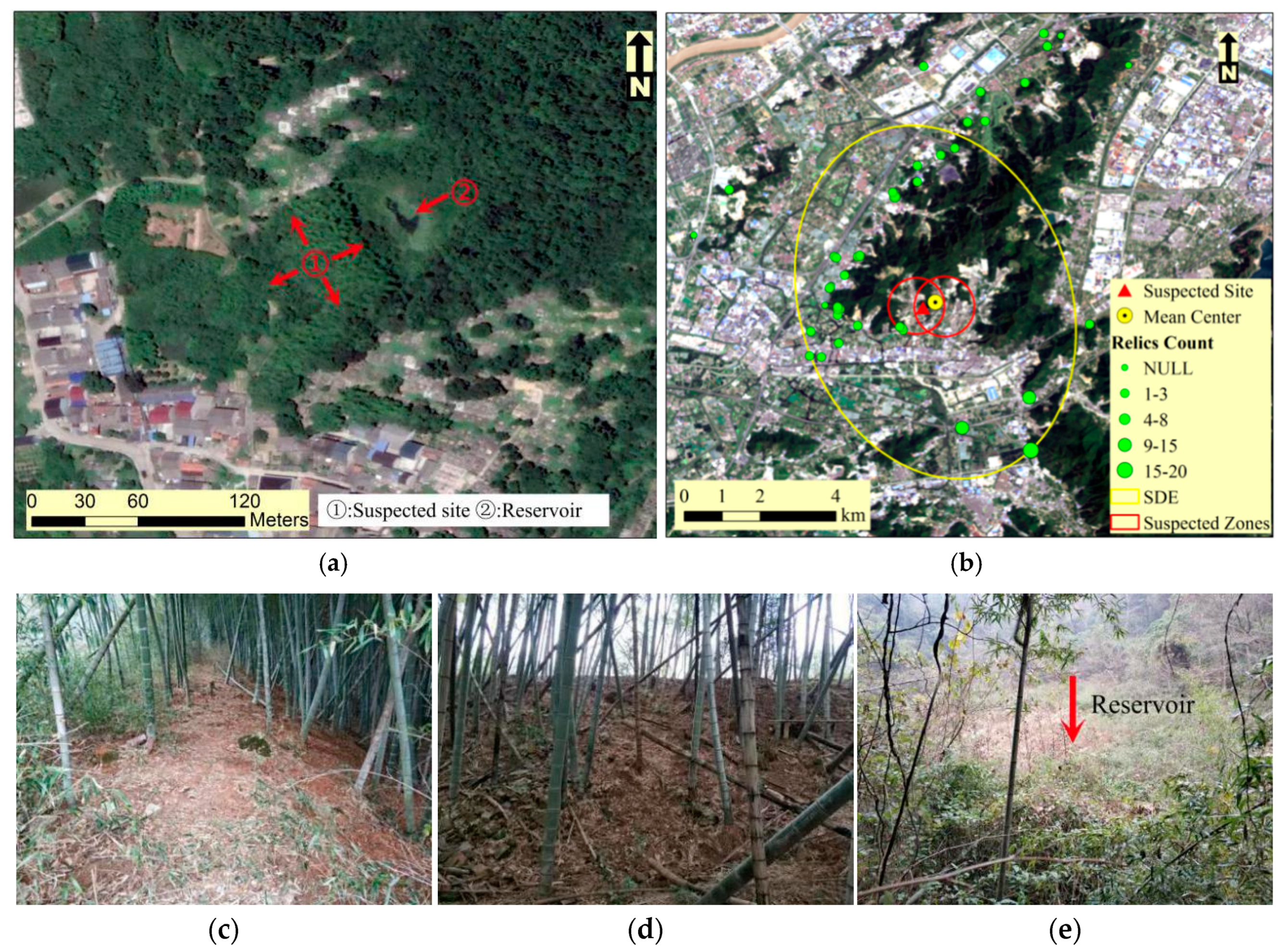
| Equation | Description |
|---|---|
| α: the ratio of the number of links in a network to the maximum number of links possible. α = 0 means no loop circuit in the network, and α = 1 means the maximum possible number of loops in the network. | |
| β: the average connections of each vertex. When β = 0, there is no network connection between nodes; when β < 1, it represents incomplete structures of the network; β = 3 means the best network structure. | |
| γ: the ratio of the number of links in a network to the maximum number of possible links. The condition γ = 0 occurs when no vertex is connected, while γ = 1 occurs when every vertex is connected in the network. |
| Data | Landsat OLI | Landsat TM | SRTM DEM | Corona | Google Earth |
|---|---|---|---|---|---|
| Time | 24 August 2017 | 12 August 1995 | 2003 | 21 December 1964 | 21 December 1984 |
| Classification | Relics Number | Patch Number | Mean Perimeter | Mean Area | ||||
|---|---|---|---|---|---|---|---|---|
| 1995 | 2017 | 1995 | 2017 | 1995 | 2017 | 1995 | 2017 | |
| Bare land | 9 | 7 | 7 | 7 | 977.14 | 1474.29 | 1.62 | 5.57 |
| Farmland | 39 | 20 | 30 | 20 | 61,046.00 | 5946.00 | 412.76 | 35.24 |
| Forest | 96 | 66 | 19 | 25 | 244,812.63 | 413,988.00 | 12,128.98 | 8092.58 |
| Settlement | 12 | 61 | 11 | 54 | 15,027.27 | 6907.78 | 73.04 | 33.04 |
| Water | 2 | 4 | 2 | 4 | 510.00 | 3345,00 | 1.17 | 33.23 |
| Year | Mean Edge Intensity in 1995 | Mean Edge Intensity in 2017 | ||||||||||
|---|---|---|---|---|---|---|---|---|---|---|---|---|
| Scale (m) | 100 | 200 | 400 | 600 | 800 | 1000 | 100 | 200 | 400 | 600 | 800 | 1000 |
| Forest | 2.26 | 2.98 | 4.32 | 5.92 | 7.74 | 9.03 | 2.50 | 3.48 | 5.36 | 7.63 | 9.96 | 11.61 |
| Water | 2.46 | 5.69 | 7.1 | 6.65 | 8.93 | 9.78 | 2.27 | 3.88 | 5.76 | 8.07 | 10.01 | 11.54 |
| Farmland | 2.2 | 3.50 | 5.55 | 7.54 | 9.52 | 10.99 | 2.41 | 4.06 | 6.47 | 8.37 | 11.01 | 12.78 |
| Bare land | 2.67 | 4.26 | 5.97 | 8.20 | 10.30 | 11.84 | 1.76 | 2.73 | 5.47 | 8.22 | 10.24 | 11.50 |
| Settlement | 2.16 | 3.33 | 5.02 | 7.10 | 9.36 | 10.85 | 2.05 | 3.72 | 5.73 | 7.82 | 10.22 | 12.03 |
| Holistic Evaluation | GZ 1995 | GZ 2017 | YX 1995 | YX 2017 |
|---|---|---|---|---|
| Area, a (km2) | 47.76 | 47.76 | 25.83 | 25.83 |
| Vertex Number, v | 81 | 125 | 32 | 68 |
| Edge Number, e | 223 | 346 | 79 | 182 |
| Circuitry, α | 0.91 | 0.91 | 0.81 | 0.88 |
| Ratio of Edge to Vertex, β | 2.75 | 2.77 | 2.47 | 2.68 |
| Connectivity, γ | 0.94 | 0.94 | 0.88 | 0.92 |
© 2019 by the authors. Licensee MDPI, Basel, Switzerland. This article is an open access article distributed under the terms and conditions of the Creative Commons Attribution (CC BY) license (http://creativecommons.org/licenses/by/4.0/).
Share and Cite
Zhu, J.; Yu, L.; Nie, Y.; Liu, F.; Sun, Y.; Zhang, Y.; Song, W. Ancient Environmental Preference and the Site Selection Pattern Based on the Edge Effect and Network Structure in An Ecosystem. Sustainability 2020, 12, 328. https://doi.org/10.3390/su12010328
Zhu J, Yu L, Nie Y, Liu F, Sun Y, Zhang Y, Song W. Ancient Environmental Preference and the Site Selection Pattern Based on the Edge Effect and Network Structure in An Ecosystem. Sustainability. 2020; 12(1):328. https://doi.org/10.3390/su12010328
Chicago/Turabian StyleZhu, Jianfeng, Lijun Yu, Yueping Nie, Fang Liu, Yu Sun, Yuanzhi Zhang, and Wenping Song. 2020. "Ancient Environmental Preference and the Site Selection Pattern Based on the Edge Effect and Network Structure in An Ecosystem" Sustainability 12, no. 1: 328. https://doi.org/10.3390/su12010328
APA StyleZhu, J., Yu, L., Nie, Y., Liu, F., Sun, Y., Zhang, Y., & Song, W. (2020). Ancient Environmental Preference and the Site Selection Pattern Based on the Edge Effect and Network Structure in An Ecosystem. Sustainability, 12(1), 328. https://doi.org/10.3390/su12010328





